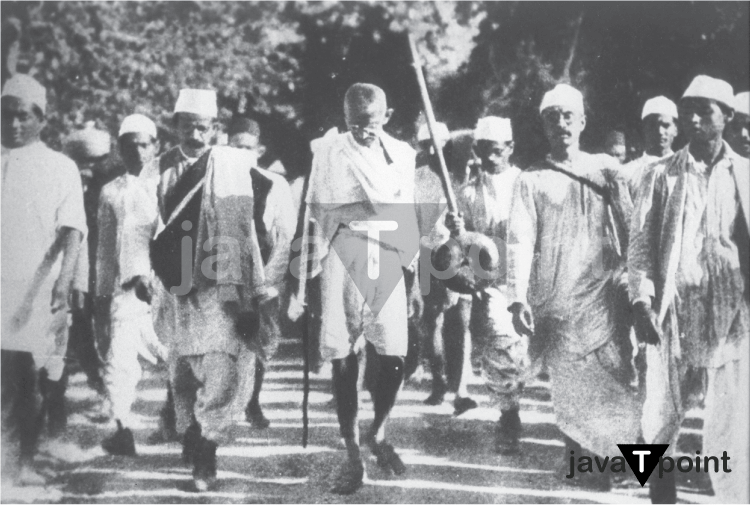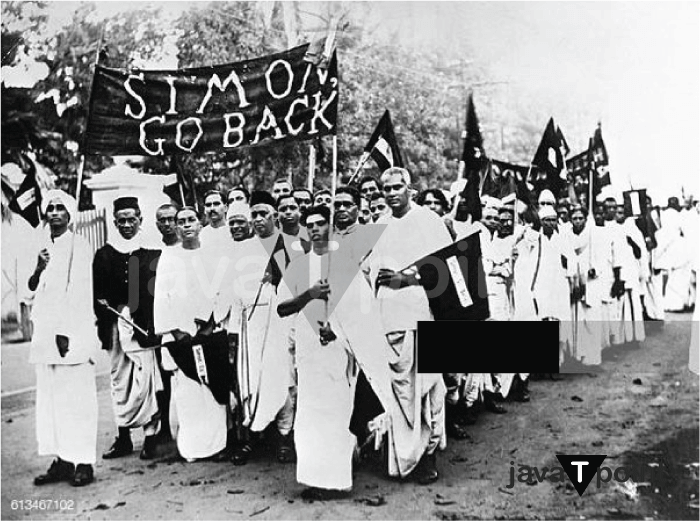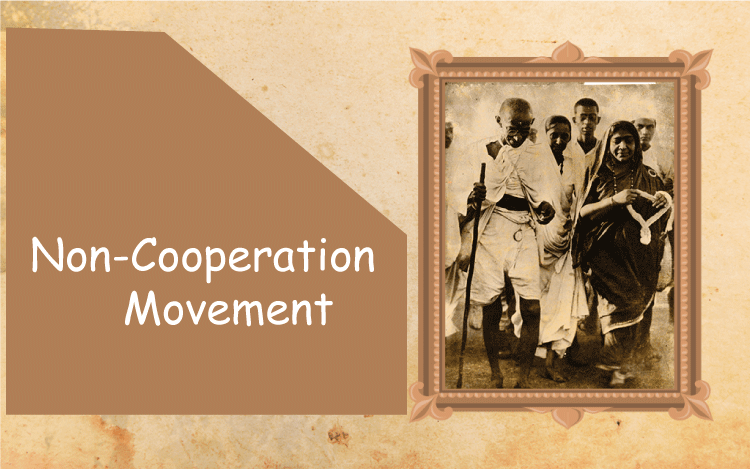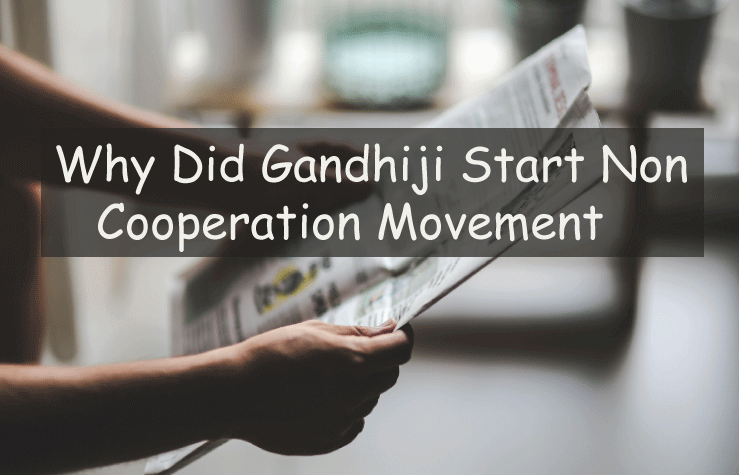Difference Between Non- Cooperation Movement and Civil DisobedienceThe Non-cooperation movement and the Movement for civil disobedience were two significant movements in the struggle for independence at the start of the 20th century. These two-movement, which took place ten years apart, held a key place in the development of the Gandhian Movement. In September 1920, the Non-cooperation movement got its beginnings. Gandhi saw the effort to rid Indian politics of corruption, terrorism, and racism as a political and religious movement. The Civil Disobedience movement began in March 1930, and on April 6, 1930, Gandhi breached the salt rule by procuring a lump of salt at Dandi. The breaking of the law was interpreted as a representation of the Indian people's determination not to live under British authority, which is to say, under British domination. Gandhi publicly urged people to break the law against salt by producing salt from seawater in their houses. 
What is Civil Disobedience?While civil disobedience is using nonviolent means to disobey a nation's laws, the opposite is also a definition of civil disobedience. Most often, it is brought on by people's moral objections. For instance, if a group of people feels that legislation that has been approved is immoral, there is a good probability that they will refuse to follow this law and engage in actions like rallies to show their resistance. Similar to when someone chooses not to cooperate, this can be viewed as passive because no violence is involved. This Movement also occurred in various nations, including India, America, and Africa. Labor union activities involving protests by members to obtain better working conditions or employee rights are examples of civil disobedience. A group commits civil disobedience when they refuse to follow certain legislation. It does not mean that the current political system or the administration is to be completely rejected. 
Why Did Gandhiji Choose Salt as a Weapon?Salt was selected to symbolize the start of the civil disobedience campaign because it was thought to be a fundamental right of every Indian. Gandhi once said, "There is no product other than water that the government can tax to feed the millions of people who are starving, as well as the sick, the injured, and the defenceless." It is the cruelest poll levy ever created by man. Salt directly linked the Swaraj ideal and a real and frequent complaint of impoverished rural people. (and with no socially divisive implications like a no-rent campaign). Like khadi, salt allowed urban believers to metaphorically connect to widespread suffering while providing the impoverished with a small but mentally important source of income through self-help. What are the Demands of Gandhi During the Civil Disobedience Movement?Gandhi presented the British administration with eleven requests for consideration. These requests received no response from the British. Gandhi's demands included the release of political prisoners, acceptance of the Postal Reservation Bill, a reduction in the rupee-pound exchange rate, the introduction of textile protection, the reserving of coastal shipping for Indians, the introduction of total prohibition, reforms to the Criminal Investigation Department (CID), a change to the Arms Act allowing public control of the issuance of a firearms license, and the reduction of land revenue by 50%. Civil Disobedience Movement British Government's ResponseThe British government convened the first round table meeting to discuss the changes the Simon Commission suggested in November 1930. The Indian National Congress, however, decided to abstain. The meeting was attended by Indian nobles, the Muslim League, the Hindu Mahasabha, and a few other groups. However, nothing came of it. As the British understood, no significant constitutional amendments would be made without Congress' participation. The Congress was persuaded to participate in the second round table conference by Viceroy Lord Irwin. Gandhi and Irwin reached a compromise whereby the government vowed to release all political inmates who had not been charged with using violence. Congress promised to end the civil disobedience campaign. The Karachi assembly in 1931, presided over by Vallabhbhai Patel, decided that the Congress would participate in the second round table congress. Gandhi served as the session's representative in September 1931. Women in Civil DisobedienceThe 1930 civil resistance marked the first time women joined in large numbers in the fight for independence. Thousands of women participated in the satyagraha, from big towns to tiny villages. Although Gandhi requested that only males participate in the salt march, women ultimately started producing and selling salt all over India. Even though only males were permitted to participate in the march, it was obvious that both sexes were expected to advance efforts to end the salt regulations. Even our elderly aunts, great-aunts, and grandparents used to transport pitchers of salt water to their homes and make illicit salt, according to Usha Mehta, a pioneering Gandhian activist. "We have broken the salt law!" they would yell at the top of their lungs. Lord Irwin referred to the increased involvement of women in the struggle for independence and self-rule as a "new and serious characteristic." "Thousands of them emerged... from the seclusion of their homes... to join Congress demonstrations and assist in picketing," according to a government report on women's participation. "Their presence on these occasions did the work the police was required to perform particularly unpleasant," the report stated. Even though women participated in the march, it was apparent that Gandhi considered them as still having a supporting role in the Movement. Nevertheless, Gandhi started the Movement's drive for women to be more active in the future. "One of the most well-known leaders in pre-independent India, was Sarojini Naidu. She was a passionate supporter of India and actively rallied support for the Indian independence cause while serving as president of the Indian National Congress and the first female governor of independent India. She was the first woman detained during the salt march as well." Civil Disobedience Movement ImpactFollowing Gandhi's symbolic violation of the salt prohibitions at Dandi, disobedience to the rules spread throughout the country. During CDM, men and women from all areas of life-students, women, tribal people, company owners, laborers, and peasants-disobeyed several provincial salt regulations. The Salt Satyagraha was conducted by C. Rajagopalachari in Tamil Nadu, K. Kelappan in Malabar, Sarojini Naidu, and Manilal Gandhi at Dharasana Salt Works (Gujarat), among others. Following Gandhi's footsteps, Rajagopalachari in Tamil Nadu conducted a similar march from Trichinopoly to Vedaranyam. Notable representative Sarojini Naidu was in charge of the protest in Dharasana, Gujarat, at the same time. A police lathi assault resulted in severe injuries to over 300 Satyagrahis. Consequently, there were demonstrations, hartals, a boycott of foreign products, and, eventually, a failure to pay taxes. One thousand individuals, mostly women, participated in this effort. At the Dharasana salt factory, noteworthy for the scale of its nonviolent resistance, a group of 2000 volunteers defied the salt laws despite a sizable police force beating non-resisting Satyagrahis (protesters) until they fell. Limitations of the Civil Disobedience Movement
What is Non-Cooperation?Non-cooperation is when several people either reject or fail to cooperate with a nation's administration. It can be seen as passive resistance in this way. This could be seen as a tactic used by one group to demonstrate their resistance by declining to participate in civic and political discourse. This specific move aims to fail the government by cutting off all aid. For instance, if several champions leave simultaneously, work will be disrupted. The goal of Non-cooperation is to achieve electoral success in this way. This was apparent as a movement in India, particularly through Mahatma Gandhi's deeds while the British were in power. This included resigning various titles, refusing to pay taxes, and boycotting foreign services and products. 
Why Was Non-Cooperation Movement Called Off?Mahatma Gandhi chose to stop the campaign in February 1922 after the Chauri Chaura disaster. In Chauri Chaura, Uttar Pradesh, during a confrontation between the police and movement protestors, a tumultuous mob set fire to a police station, murdering 22 officers. Gandhi ended the protests by claiming that the people were not ready to topple the government through the practice of ahimsa. Motilal Nehru and C. R. Das were two prominent individuals who resisted ending the campaign due to sporadic incidents of violence. Impact of Non-Cooperation Movement
People from various parts of the nation cooperated fully with the great leaders who backed the cause. Because the nationalist exploitation of the Swadeshi movement had helped them, the business community supported the Movement. Peasants and middle-class members could voice their disapproval of British authority by joining the campaign. Women enthusiastically participated in the Non-Cooperation Movement and demonstrated. Plantation laborers prohibited from leaving the tea gardens and plantation areas backed the Gandhian campaign. Many individuals also abandoned the titles and honors conferred upon them by the British crown. People had started to demonstrate against organizations administered by the British government, such as courts and colleges. Non-Cooperation Movement by Mahatma Gandhi
The main supporter of the Non-Cooperation Movement was Mahatma Gandhi. In March 1920, he released a manifesto defining the Movement's peaceful Non-cooperation tenets. Gandhi sought to end untouchability by adopting Swadeshi concepts and customs, such as hand spinning and weaving, with the aid of this manifesto. Gandhi visited the nation in 1921, explaining the Movement's tenets. Non-Cooperation Movement CausesIndians thought they would be granted independence after the war as payment for the significant personnel and material assistance they had provided to Britain during the First World War. However, the Government of India Act of 1919 was insufficient. The British also passed oppressive laws like the Rowlatt Act, which infuriated the Indians even more. Many felt deceived by the authorities despite their support for the war effort. The Home Rule Movement, which Annie Besant and Bal Gangadhar Tilak started, is where the Non-cooperation Movement started. Modest and radical members of the INC merged, and the Lucknow Pact saw collaboration between the Congress Party and the Muslim League. The resurgence of the radicals gave the INC a militant image. India's involvement in the war caused significant financial hardship for the populace. The cost of goods began to increase, which affected the average individual. Peasants also endured as a result of the farming products' stagnant prices. Resentment towards the administration was the outcome of everything. The brutal Jallianwala Bagh massacre in Amritsar and the authoritarian Rowlatt Act significantly impacted the Indian government and its citizens. The entire country backed its leaders as they advocated for a more assertive and unyielding stance against the government because their faith in the British judicial system had been shaken. During the First World War, Turkey, one of the Central Powers, fought the British. After Turkey's defeat, the end of the Ottoman Empire was proposed. The Sultan of Turkey was regarded as the Caliph of Islam. (Religious head of the Muslims). The Khilafat Movement was started by the Ali Brothers (Maulana Mohammed Ali and Maulana Shaukat Ali), Maulana Azad, Hakim Ajmal Khan, and Hasrat Mohani. Mahatma Gandhi offered assistance to persuade the British government to maintain the kingdom. The Movement's leaders organized a united protest against the British and joined Gandhi's Non-cooperation movement. End of Non-cooperation MovementThe Chauri Chaura episode led to the withdrawal of the Non-cooperation campaign. Mahatma Gandhi was detained on February 12, 1922, even though he had single-handedly ended the national uprising. He was sentenced to six years in jail on March 18, 1922, for publishing seditious literature. As a result, the organization was put down, and other officials were then taken into custody. The Ali brothers were among the leaders who broke away from Gandhi even though most Congressmen stayed solidly behind him. (Shaukat Ali and Mohammad Ali Jouhar). Motilal Nehru and Chittaranjan Das founded the Swaraj Party to challenge Gandhi's rule. While most nationalists still believed in Gandhi, they were discouraged because many believed the Non-cooperation campaign should not have been put on hold because of a few violent incidents. Difference Between the Two Movements
1. Area Confined The non-cooperation Movement was only present in a small region. The most remote area of the country and the country's southernmost regions were not affected. The Movement of civil disobedience was restricted to a bigger region. This Movement simultaneously extended to other regions of the nation. C. Rajagopalachari headed the Movement in Tamil Nadu, while K. Kelappan led it in Malabar. Other regions where the Movement took hold included Assam, Bengal, Orissa, and Bihar. 2. Spirit of Nationalism The Non-cooperation Movement was the first large-scale Movement to spark nationalist sentiment among the populace after Gandhi entered national politics. The civil disobedience movement emerged after ten years of freedom struggle. The Later Movement of Civil Disobedience did not exhibit the nationalism sown among the populace by the Non-cooperation movement. 3. Aim of Movements Gandhi decided the primary goal of the Non-cooperation movement was to persuade the British to secure Swaraj for India in response to the Jallianwala Bagh massacre and other acts of violence in Punjab. In addition, he promised that if his Non-cooperation program were fully implemented, India would obtain Swaraj within a year. They did not demand total independence at the time. The leaders of the Civil Disobedience Movement pushed for total independence. On December 29, 1929, the Indian National Congress announced Poorna Swaraj to be the Congress's goal. 4. Coincidence With Other Movement The Moplah uprising and the Eka movement, two distinct peasant movements that gave the Non-cooperation movement distinctive strengths, occurred simultaneously. The civil disobedience campaign, in contrast, did not coincide with any large peasant or labor insurrection. 5. Position of the Congress The Congress wasn't all that strong during the Non-cooperation movement but was institutionally stronger during the civil disobedience campaign. They were now certain India could achieve total independence and drive the British out of the nation. Another benefit for the nation came with the 1928 publication of the Nehru report. 6. Impact of the Movement Gandhi firmly opposed violence throughout the Non-cooperation movement, and he ended it following the unanticipated Chauri-Chaura episode, which claimed the lives of 22 police officers. Every segment of the population-artisans, peasants, students, urban poor, women, and traders-was politicized by the Non-cooperation Movement, which stoked nationalist feelings throughout the entire nation. Millions of men and women were politicized and made active, which gave the national Movement a revolutionary feel. The government experienced the effects of the CDM. Foreign textile and other product imports decreased, and the government lost money from excise, spirits, and land taxes. The Legislative Assembly elections were mainly boycotted. 7. Involvement of Different Sections of Society
8. Government Response Since the government was not in the mood to negotiate, police firings started happening everywhere to end the Non-cooperation movement. Public gatherings were prohibited, and the majority of the leaders were detained. Additionally, it was noted that the Congress and Khilafat voluntary organizations had been deemed unlawful. Throughout 1930, the government's stance was conflicted, perplexed, and ambiguous. Determining whether to use force or not was difficult. Numerous people were injured by lathi charges and gunfire directed at defenceless masses, and thousands of satyagrahis were imprisoned, in addition to Gandhi and other leaders of the Congress. The government removed the salt levy it had placed on the populace after observing the strength of CDM. Tabular Difference Between Non- Cooperation Movement and Civil Disobedience
ConclusionThe Civil Disobedience Movement and the Non-cooperation Movement each have a purpose and a conclusion. Three times more people were locked up during the civil disobedience movement than during the Non-cooperation movement. By doing so, we can see that the Civil Disobedience Movement attracted considerably more people than any other Movement. Both the Non-cooperation and civil disobedience movements have had a significant historical impact on the history of the freedom struggle; however, the differences between the two movements are confined to their respective natures, levels of public participation, and responses from the authorities.
Next TopicDifference Between
|
 For Videos Join Our Youtube Channel: Join Now
For Videos Join Our Youtube Channel: Join Now
Feedback
- Send your Feedback to [email protected]
Help Others, Please Share










